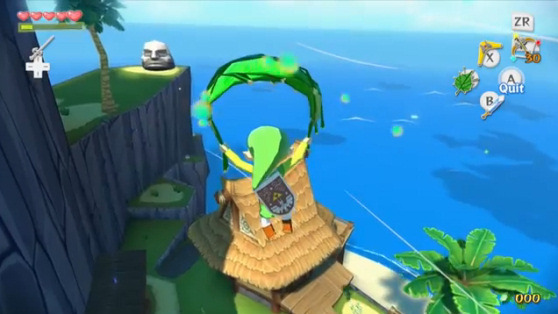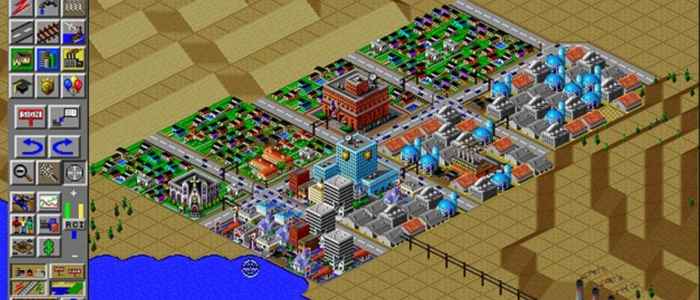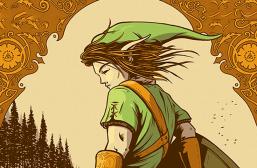Games as Art: Displacement within the Art Gallery
In 1996, the game Super Mario 64 saw players controlling the titular hero as he wandered the halls of Princess Peach’s castle. Paintings on the walls provided the means through which Mario could access the game’s core playable spaces: jump through one and you would find yourself in another world to play in and interact with. It was a clever trick of the developers to reduce the load time of the game’s overworld and compartmentalize level design. It also spoke to a future of sorts; one in which videogames themselves lined gallery walls as artworks rather than static images. Today that prediction is gradually becoming a reality as videogames increasingly become regarded as artworks, finding their way into gallery spaces as well as dedicated exhibitions. What does this mean for videogames, though? How does their nature as interactive entertainment impact the practice of displaying them for public use?

In order to best consider the complications that this issue presents, one must first understand the motivations behind these new display techniques and the growing practice of videogame academia. With the increasing consideration of videogames as cultural artifacts, a greater number of people and institutions have begun to consider the effects of games on human behaviour, its role in society, and more. Most importantly, the people who are making these observations increasingly come from gaming backgrounds, rather than as outsiders looking in at a hobby they don’t personally enjoy. This growing fascination with the higher-minded concepts of videogames is similar to what occurred in film and television studies 50 years ago. This means that, like the new media of the 20th Century, their role as artworks is under increasing scrutiny.
As gamers it is understandable to want our hobby to be accepted as an art form by the general public, by gamers and non-gamers alike. After all, we are able to appreciate the incredible intellectual and emotional intricacies that a well-designed game can demonstrate. If that doesn’t constitute a work of art, then what does? This belief is a common one, and it grows more prevalent the more people identify as gamers. Ultimately, however, the status as artworks that games maintain is one of uncertainty; both because of their constant technological and design evolutions, as well as the fact that there is no consensus on what makes a videogame a work of art in the first place.

Now it would be foolish to try and determine a unified rule set for what constitutes art, especially considering that one of the most discussed art pieces of the 20th Century was essentially a urinal placed on top of a plinth, much to the displeasure of those uninitiated in art history. Nonetheless, there must be some way to determine what makes a videogame unique as an artwork. There has to be some criteria through which we can say, “Yes, that game is a work of art!”
Fundamentally determining what makes a game a work of art is as much about what games are not as well as what they actually are. Suffice it to say, games are not movies, despite the constant comparisons between the two. They also aren’t paintings, sculptures, songs, performance pieces, or any other accepted form of art, though they make use of elements from all of these mediums. They are a new form of expression – a modern medium. One which makes use of modern technology in a way that others don’t. In order to best understand the artistic merit that videogames contain, we need to understand how they do this, as well as accept the ways that they embrace, and defy, aspects of art as we typically understand it.
What sets games apart?
Compared to the most recognizable artistic medium – painting – videogames are considerably unique. Interactive as well as highly scripted, they invite you to play as you want while limiting the actual gameplay to what the game engine allows for. Visuals and audio make up the bulk of the player experience, but the gameplay is the result of meticulously constructed digital codes. Rarely do they have a single author, though the director is often given final credit for a game, yet when we compare other artworks such as paintings those tend to exist as a smaller part of a single artist’s oeuvre. With this in mind it’s little wonder that experts tend to equate the artistic qualities of videogames with those of film rather than painting. The problem is that compared even to films, videogames differ significantly enough that their artistic contributions require special consideration.
On a purely visual level there are similarities between the two, as both require a certain level of aesthetic sophistication. This has always been the most straightforward way of understanding art as well, as most people are raised to believe that higher visual fidelity equals higher quality art. Typically, clear, realistic visuals are easy to comprehend and thus exist as the benchmark for most people’s artistic standards. In terms of videogames and film this translates to a rule that states: if the visuals are beautiful, if they make you feel something, then it is a work of art.

There is nothing wrong with this perspective, just as there’s nothing wrong with preferring naturalism to abstraction in painting or narrative film to experimental film. Art, after all, is subjective, and there is no wrong way to appreciate a work. For many the visuals of a videogame are what constitute the artful component, with the gameplay presenting that of entertainment. For instance, Bioware’s Dragon Age: Inqusition presents players with a vibrantly coloured fantasy world. An interesting design choice on the part of the developers, especially at a time when many action games focus more on gritty and grimy realism, it caught the eye of many players and critics alike, setting it apart from the competition. If a beautifully rendered game world is what you consider to be a work of art, then Inquisition will appeal to you. The problem is that, for those who want to consider a videogame in its entirety as a work of art, the focus on visuals simply won’t be enough.
An excellent example of this problem would be many of Blizzard Activision’s games. Blizzard’s cinematic team has created some truly astounding CG cutscenes and trailers in the company’s long history, many of which could challenge those of a hollywood movie studio in terms of quality. These video components take an enormous amount of time and effort to complete, as well as a high level of creative input. Warcraft III is positively loaded with them, punctuating each chapter of the game with a gorgeous and exciting cutscene. Once the segment is finished however, and the game reminds you that you are there to actually play it and not watch it, one cannot help feel the dissonance. Pre-rendered cutscenes, for all their beauty and dramatic flair, are not gameplay. Even videogames that utilize their own game engine to make their cutscenes, like the aforementioned Dragon Age: Inquisition, still encourage players to sit and watch rather than to play (though there is something to be said about interactive cutscenes). None of this is to say that these cutscenes shouldn’t be considered art; they certainly are. When calling a game a work of art though, one must stop and question whether it is the game itself we are considering or the movies contained within.

Games are combined wholes of many different elements. Video, audio, story, design – they all unite to create a working product. An excellent game cannot stand without some of these working together and working well, and to dissect one element out of the game as proof that it is a work of art, while ignoring the others, simply isn’t a strong enough argument for some. Visuals, as integral to the art experience as they are, are only a piece of the puzzle with videogames. If the art criticism of games is to advance then so must the definition of games as artworks, and if they are to be accepted as their own, unique form of artistic expression then what makes them unique should factor into the equation.
It is likely that gameplay is the answer. As was stated earlier, games are interactive. Highly so. They simply cannot function without some kind of human direction. In this respect they are similar to the happenings and performance art pieces of the late 20th century. Games are unique, however, in that their performances are largely personal. Even multiplayer games adhere to this rule, as your experience, your gameplay choices, are yours and yours alone. This is the most notable difference between videogames and film. A film is linear, scripted and impersonal; it asks only that you watch and listen. A videogame however is much more complex and intimate, demanding that we provide input in order to attain some enjoyment from it.
It is this quality, the gameplay, which truly sets videogames apart from other art forms. It allows a videogame to make a statement about something in a way that other mediums cannot. Experiences like those of the original Bioshock, which twisted our perception of player agency, would have been diminished if not completely lost were the experience translated into a movie. Similarly, Dark Souls and its strangely captivating themes of struggle and futility resonate with players largely because they permeate the entirety of the game, from its story to its gameplay to even its user interface. Especially relevant are non-narrative games, such as SimCity, which presents the experience of building and managing a city in a way that only a videogame can through interaction. It’s these personal experiences, often stretched over long periods of time, which communicate ideas more dynamically than static paintings do or even story driven films.
It may seem obvious but it really is the “gamey” elements of videogames that should be our focus when considering their artistic merit. However, it often is the case that we discount this aspect when discussing games to non-gamers. We shy away from it, fearing that acknowledging that a game is in fact a game somehow reduces its intellectual or cultural value. We fear that we will turn it into a toy, as if that were a bad thing. The truth is that if gameplay is what makes videogames unique compared to other art forms, then that’s what should be embraced. Game design is complex and requires a certain level of vision to be carried out effectively. Though that may not fit everyone’s criteria for artistic value it certainly fits some.

Missing the Point
Evidently some prominent institutions agree that videogames could be considered art, such as the Museum of Modern Art with its Applied Design exhibit – an art establishment that now displays videogames in the same building that houses works by Van Gogh and Picasso. Inviting visitors to play small portions of the game before handing the controller over to the next participant, the MoMA has essentially created a small-scale arcade, with that wonderful level of pretension that only elite art institutions can produce. On the surface this may seem like fantastic news for those looking to increase the cultural and social ranking of videogames. Unfortunately, while on the surface the case of the MoMA may seem like proof that games have been accepted as high art pieces, the truth is that the exhibit leaves much to be desired.

The problem reveals itself partly in the title: Applied Design. The systems of videogames is where the MoMA draws most of it inspirations from, and where they get things only half right. The design that the MoMA dedicates its exhibit to could best be described as anything technologically interesting and interactive. The dimensional twisting elements of Portal for instance, or the voxel cube world of Minecraft. Pac-Man is on display, not so much for its technological marvel but more for the enduring appeal of its gameplay. The Applied Design exhibit assembles a range of videogames that stand out in the history of the industry. Each one a marker for when something great occurred and more people took to gaming as a hobby. This is all wonderful from a business standpoint and easily marketable for the MoMA; “Come see your favourite games in our grand institution! We get it now! They’re works of art after all!” As great as this may seem to gamers though, it mostly misses the point: videogames like Portal and Minecraft simply are not playable in a public setting the same way they are at home, a design element the MoMA overlooks.
A focus purely gameplay, especially from the more unschooled point of view that the MoMA attempts to exploit, ignores the overall experience of the videogame. Portal was designed to be played from start to finish in a linear fashion, ideally by a single player. While it may be possible that someone unfamiliar with the game could jump into the middle of a linear title for ten minutes of play time and enjoy some of its unique mechanics, more likely than not, they will simply walk away confused. Parceling a modern, mainstream videogame like Portal into a short demo simply does not promote an appreciation of the game in any meaningful way, and ignores the actual artistic value that a game like actually has; a value which lies in the entirety of the game experience, from beginning to end.

Portal is more than just a game that featured a new way of traversing three-dimensional environments. It was a story about a prisoner attempting to humour her warden before rebelling and making her escape. It was a practice in isolation and frustration as well as the satisfaction of success. It was an aesthetic journey of sleek, minimalist design and futuristic veneer. Portal was a combination of all these elements and more, none of which can be appreciated in the same span of time it takes to drink a coffee, which is exactly what the MoMA have encouraged.
Applied Design is less a celebration of each displayed game’s entirety and more their individual contributions to the growth of the medium through their unique design elements. It’s a chronological journey through “gaming’s greatest hits.” The good thing is that if that is what you want out of a videogame exhibit then it is a resounding success. This is not meant to be derisive as there is certainly value to this practice, and in fact could be a sign of more things to come. For those who are more interested in the themes that these games explore, however, for the self-evaluation that some games like Bioshock promote, then perhaps a more specific exhibit is necessary. As it stands right now though, there is little appreciation for videogames as anything other than a collection of smaller things – coding, cinematics, audio, design, etc. – rather than as singular wholes.
The attempts of the high art institutions to include videogames in their exhibits should not be without credit. For many of their guests it might expose them to the idea of a videogame operating as a high art concept, something they might not have considered before. But then again, the MoMA has developed a reputation as the foremost institution in regards to contemporary art and with that expectation comes a large number of visitors. It may sound pessimistic but the Applied Design exhibit was made with a particular kind of person in mind. The kind of people who buy memberships at the MoMA and go there on a regular basis: the “Average Joe” of art museum visitors. In other words, not for gamers. The MoMA’s exhibit caters to a more pedestrian level of videogame knowledge. Those of us who immerse ourselves in the medium on a regular basis likely won’t be getting much out of it, as the importance of gameplay innovations and of the titles on display are already firmly entrenched in our minds.
How to Move Forward
How then do we celebrate the artistic merit of videogames in a public setting? If the most well known contemporary art museum in the world cannot create an exhibit to adequately communicate the artful qualities of a videogame then what hope is there for anyone else? How do we appreciate videogames as artworks in large, publicly accessible spaces? The answer, for now, is: why should we try?
Videogames are performative, as was earlier made clear, and also deeply personal. Even multiplayer games. You might be able to appreciate Super Smash Bros: Wii U more with a group of friends, but your experiences is still unique, still your own. Most importantly, it is not limited to a single space where the image might be on display. The original The Starry Night might be in the MoMA but there are millions of copies of Super Smash Bros: Wii U in peoples homes while we speak, each one of which is identical to the other.

Videogames still are not paintings, sculptures or any other traditionally understood art media. They demonstrate their value over time rather than in a single brief experience and they do so at our own pace. Now, more than ever, they are designed with home use in mind, not public display. Any attempt at reversing that paradigm will feel awkward and forced to someone with a more than cursory knowledge of the medium, as it exists today.
And sure, the argument can be made that owning The Starry Night and viewing it at home is a more valuable experience than viewing it in a crowded gallery. Photography and the internet have even facilitated a somewhat similar experience. The issue remains, however, that the gallery space as we typically understand it has evolved to allow for an appreciation of paintings in a crowded setting while it’s treatment of videogames remains lacking. Games are not the only art form to require a space outside of the gallery to function, but nonetheless there is still a desire to see them there. To fit them in like a puzzle piece that might not belong. Videogames do not need gallery spaces to function as artworks and as such the standards by which we judge them as art don’t need to be interchangeable with the other mediums.
The truth is that the appreciation of videogames as an art form has already begun. Websites such as this are proof of that. Games are more numerous and varied than ever before, and even the lines between what constitutes a game and a non-game are becoming blurred. Realistically rendered and action packed games like Dark Souls exist on the Steam marketplace alongside smaller, more modestly budgeted and visually unique games like Mountain. While one certainly has a larger fan base than the other they both generate their fair share of interest as well as stimulating conversation. They are also radically different from one another in nearly every conceivable way. Some might claim that games like Mountain don’t qualify as a proper videogames, and its limited sales could certainly be touted as proof that its appeal is too niche. One could even argue that, in opposition to the mainstream games of today, Mountain actually would be well suited for traditional gallery display. This is a discussion for another day though. For now one should accept that it exists on the market as a game and, at the least, serves as an example of the growing diversity of the medium.

The quandary that we find ourselves in – attempting to appreciate videogames as artworks – is not one that has a single, perfect solution. Because of the subjectivity of art as well as the growing diversity of modern game design and the rise of counterculture videogames (see Dear Esther) there can exist no proper answer. One thing is certain, though: as long as videogames continue to be designed for personal rather than public use they will undoubtedly create a sense of displacement when inserted into traditional art galleries. The growing cultural legitimacy of videogames has instead created a wealth of discussion, especially online where gaming culture and tropes are most easily understood. Perhaps the future will bring change as videogames continue to permeate most aspects of our digital technology. Until then we should be content with the growing discourse surrounding the medium and the fact that, much like other modern art forms, it does not need a gallery space to function as a work of art.
What do you think? Leave a comment.











“if the visuals are beautiful, if they make you feel something, then it is a work of art.” This is well said, it can be applicable to both the formal study of art as well as the layman or informal appreciation for art. Thank you for impressing upon me that video games contain a great measure of art.
Last time a video game exhibit came to my city, it was placed in a science museum. I suppose they were taking a different approach and demonstrating how video games evolved, but it’s interesting to see how video games can also be considered a work of art.
Thanks for the read!
I had a similar experience in Toronto. Game On 2.0 arrived and was set up at the Science Centre. I thought it was interesting; a chronological approach to videogames. I was a little disappointed that they didn’t go into more depth with their material though. All the same, it was nice to see a show like that come together with videogames as the centrepiece.
Hope you enjoyed it!
I sometimes worry about anti-intellectualism in gaming. I’ve seen too many comments in gaming communities where any attempt to analyze a game is derided as pretentious. Even worse is the defensiveness that comes out
of any criticism of a game, or gaming as a whole. Now that we’ve won the art battle it’s time to start taking our own medium seriously rather than defend it from criticism.
About time games were seen as art. They have shaped the world we live in today, like art they let us do things that are otherwise impossible. Also similar to art, they create an exploration into the depth of everyones mind. They give birth to ideas and fuel other industries as well as the Gaming industry.
Stick Bioshock in a Gallery and i’ll accept your request.
It’s not so much that the players need it validating. Rather the industry itself. It is the biggest entertainment industry in the world, and it probably employs more artists than any other. Not only that, but it has a higher perforation into modern culture than art itself.
I agree, though I don’t think we’re going to see much interesting change from the major developers. Games are art but they’re also a business and the more money that goes into a game the less likely they will be to take risks. I’m confident that we’ll see the major devs push the boundaries of realistic visuals, though, as they have the resources to do so and it’s also become something which they are expected to do.
That aside, I think we’re more likely to see a more self-aware mindset from smaller, independent developers. There’s less of a desire to tap into the broader market with them and more to go after the smaller, niche ones. The Stanley Parable, Dear Esther and other games might not appeal to everyone, but they’re different enough to be considered more radical than what many AAA developers put out every year.
The indie devs don’t have the same push that the AAA ones do, and so they won’t impact our culture as much. This isn’t unusual though. There’s more of a market for Hollywood films than there are for independent ones, after all.
Plenty of my Fine Art tutors were happy to talk about games in artistic terms, and this was probably about 8-10 years ago or so.
This made me feel old.
Very interesting, I will keep my eye on games in galleries.
I love that more and more museums are doing exhibits on video games. But, while showing the history of the medium is nice, I also hope they dedicate some of the exhibit to more artistic analysis.
Excelsior! Right?
The best painters, writers and musicians are reknowned for perfecting an existing style or pushing the boundaries of their mediums to express themselves, provoke thought in and entertain their audience, so I don’t see why the programmers and artists who do the same thing working on video games should be considered beneath them.
Most game nowadays have stunning graphics and original plots. Moving, interactive artwork
As a gamer who lives in this generation, heck yes!
I would like to see the following in arts gallery:
The Sentinel
Lords of midnight
The New Zealand Story
Is it art or just nostalgia?
There’s a great toy museum in Belgium that has a computer games floor, it is the absolute best.
Games are for children and the mentally feeble.
I haven’t got the time to play a lot of games these days, though I do remember plenty which had a particularly beauty in their design and storytelling which I would call artistic.
Games, unlike films, are open experiences that allow the player to become both a participant and a director of the overall experience through variable degrees of interactivity and freedom. Still, every choice a player makes within the boundaries of a video game is determined by the vision and parameters defined by its creators.
I won’t say that classical artworks, like paintings and sculptures are NOT interactive, emotional and dynamic – just that, in my opinion, games are MORE so because the degree of interactivity is greater.
Exhibiting Pac-Man and Tetris alongside Picasso and Van Gogh will mean game over for any real understanding of art
Some game are arts and other aren’t, just like with cinema, music, etc…
Video games always were art, it’s just that people have just started to realize that.
Having studied Fine Art at the highest level, many of the concepts of modern art are lost on the viewer; just because anyone can look, doesn’t mean anyone can understand.
So I’m surprised games haven’t been recognised earlier, as it fits nicely in the little clique.
Difference is this kind of art isn’t a wine and cheese ceremony.
I hope one day it will be recognised fully.
The Science Museum in London had an exhibit on games a few years ago. It was pretty good too.
I’m an art dealer specialized in digital art and video game artists. Games are usually only covered in mainstream media in the specialists’ segments regardless of the topic, while other cultural forms (with arguably lesser societal impact) also get covered in the ‘general’ segments. Thus getting more exposure towards a more diverse audience.
Usually games are only covered in the mainstream segment when there has been some violent incident.
Other than that I think games (like video art) are maybe an ill fit for a museum with the exception of the art of videogames and more specifically the artists of video games.
I don’t want to set the world on fire,
I just want to start a flame in your art.
Custer’s Revenge, Night Trap, Leisure Suit Larry – they should all be exhibitioned. They are part of the history of games and showed what people thought other people wanted from these new technologies.
The concept of the art is often hidden within, and many people have a problem with this.
Games require playing to unlock and appreciate all of the beauty within, and that is has isolated them from being recognised as “art.”
Looking at screenshots or footage of videogames as opposed to, you know, PLAYING them strikes me as an incredibly truncated experience, akin to watching a film with the sound off. By all means have the stills and videos but have some actual games running alongside them.
YAY games are art now!
The art in video games can’t simply be hung on a wall or placed on a plinth behind a velvet rope.
If the exhibit isn’t interactive, then I’m afraid they’ve got it very wrong.
I think this is a really timely article. With a lot of emphasis being placed on story, music and user interface it is good to see that you have drawn attention to the artistic aspects of games. All individual parts are important to make a great experience and it is great to see art getting some more of that attention.
Nice article. ‘Missing the Point’ is definitely an appropriate sub-heading. It seems that the whole ‘games as art’ argument has been misinterpreted by many as a claim that their merit lies entirely in visuals and design, which strikes me as kind of the equivalent of watching a film entirely disregarding script or performances. And like films, what makes a game special is all it’s elements working in harmony to create a certain experience. It’s far more complex and, indeed, personal than a mere sample can communicate, and as you say, there is growing evidence of a community recognising this art. Fantastic.
I’d probably stick a text adventure on display – Zork maybe – as an example of how an immersive interactive experience can be created in text alone.
Art is so subjective that it is hard define, but I think you nailed it with this article. Games are a form of art in many ways.
I hope they keep out any unrepresentative mysoginistic works that undermine gaming’s validity as an artform.
Excellent piece.
“Marcel Duchamp’s urinal” taking the piss out of art literally and showing people will buy anything you trough at them.
Even games purposely designed to be a work of art have been challenged as works of art by some critics. Despite all, I envy those artist penetrates, subverts, and modifies the videogame and its technology to turn it into something else such as Eddo Stern, Brody Condon and Josep Delappe!
Video games in my opinion have always considered to be art, it’s just taken time for others to realize. It’s unfortunate that the unlocking of certain levels inside the game must be achieved for you to fully witness the full artistical aspect of the games.
Video games in my opinion have always been considered art, it’s just taken time for others to realize. It’s unfortunate that the unlocking of levels inside the game must be achieved for you to fully witness the full artistical aspect of the games.
I believe there will be a “video game only” art gallery some day. They don’t fit when compared to old paintings or strange looking sculptures. Games are indeed a work of art, but deserve their own location for glory.
After playing “Journey” for the first time this last week, I, as a strong supporter of the idea that video games can be art, have come to the conclusion that sometimes less is best. What one person deems as being artistic will vary from person to person, same as like going through an art museum, but video games easily hold the same potential.
The article leaves me with a couple questions. You mention the disparity between cutscenes and gameplay. What do you think is the role of cutscenes in video games? Second, like you said, video games are gaining a wider public audience. However, there is still a split between an invested gamer and the regular person. Do you think there is a way to close this gap?
Cutscenes are the result of marrying a video game with linear, narrative storytelling. They are static, unchanging video files that serve the sole purpose of moving the plot forward, while gameplay is interactive and, in my opinion, the more definitively “gamey” part of video games. I don’t really think that there’s anything wrong with cutscenes from an entertainment point of view, I just believe that they are more an element of film rather than gaming.
What interests me the most about this relationship is how it has changed over the years with the introduction of interactive cutscenes as well as games like those from Telltale Games. These are ostensibly cutscenes but with the inclusion of player choice they cease to function identically to movies, and thus retain their interactive functionality.
Personally, I believe that what video games do best is interaction, and in the interest of the medium being considered a form of artistic expression, games that focus on this element, either embracing or subverting it, are more likely to be considered for their artistic qualities. That being said, I still enjoy games like Uncharted if only because they’re exciting to play/watch.
In regards to the gap between gamers and non-gamers, I don’t really believe this is a major issue, though I’m not certain by what you mean by “invested gamer and regular person.” Aside from some demographics being undeserved by AAA developers, games continue to become more popular and mainstream. Minecraft is even being used as a teaching tool in some schools now and with more children playing games we will eventually have more adults doing the same. I believe the stigma behind playing video games is all but gone in North America, although it’s study in academia is still relatively underdeveloped. However, I believe this will disappear as more people enter the field in the coming years.
Like I said, though, I’m not terribly concerned about the sheer number of gamers. I’m somewhat concerned by how open gaming can be to certain groups, but I think this is slowly improving.
I’m glad I’m not alone in thinking this topic needs more attention. I’ve previously written on the topic before, but you’ve opened my eyes to a lot of good points that I previously had not considered. Great work!
This article is very important to me. I have been trying to get people to see that video games are art for a very long time. The example of Dark Souls is perfect, as the gameplay allows the player to be drawn into the world of the game and actually relate to the themes the game explores, and to me, how is that not art? Every aspect of a game is important, is a choice, and each choice can say something different-but how those series of choices connect to create something larger is where the true artistic merit of a game lies. After all, increased difficulty previously functioned as a mean by which game developers were able to increase play time when the medium was just getting on its feet. Now, we have the technological advancements and innovations to focus on building complex narratives, vast and stunning worlds, and techniques exist to make games virtually endless. It makes such a choice to make a modern game difficult stand out. And then for that to tie in thematically? It’s indisputable.
What a great article! I loved your point about Marcel Duchamp’s “Fountain” in relation to video games as art. Fascinating!
You’re right, videogames just aren’t suited to any kind of gallery space. You can appreciate a painting or photographs hung from a wall, a film in a cinema, or drama in a theatre. To me, games are much more close to books in how we experience them as art. A book is something you have to nestle in with, enjoy at your own pace and perhaps take the odd break to digest. Any of the games that’ve really hit me as interesting artistically are ones that I remember playing for anything up to 100+ hours, definitelt not something you can just nip into a gallery to um and ah at!
I’m glad to see that the industry as a whole is starting to pay more attention to ‘arty’ games though. Not to diminish the Call of Dutys and Street Foghters of the world, they have their own mertis, but certainly there are some examples of games that hold more meaning than others, and they seem to be getting more and more prevelant as developers experiment.
An excellent point you have raised, for it is one that I think needs to be thoughtfully discussed.
Art galleries and museums were never designed with the intention to showcase a video game, or indeed any specific temporal, interactive work that can hypothetically be an endless experience. Along with the commercial aspect of video games (and indeed the fact that they are thing that you play), museum institution is perhaps the main reason why video games have not been so readily accepted as works of art throughout history. It really showcases an oversight of the system of art appreciation and recognition; if something can be placed in a gallery, then it automatically makes it a work of art (think “Fountain” by Marcel Duchamp). But what if the placement of something in a gallery jeopardises what makes that that thing worthy of attention and analysis by being counter-intuitive to its basic design and functionality?
I guess the ultimate question to all of this is: Do we need a physical space like an art gallery to inform us that something is art? I personally do not think so.
As I was reading your piece I kept comparing the individual, temporal experience of playing a game to the way films are exhibited in art museums/galleries, but then ran into a few important distinctions. While watching a film is similarly personal, most have traditionally been designed to be seen with a group of people together. This makes films much easier to be exhibited in a gallery setting, whereas games demand your individual feedback in a way that renders communal exhibition inadequate.
That said, I think that the only thing that determines the appropriateness of a game in something like MoMA is its context. If they’re simply letting the game speak for itself without considering what they want people to get out of whatever portion of it they have curated, then there’s really no reason for it to be there since playing the game in that environment wouldn’t be any more enlightening than playing it at home. However, I do think there is something to be said for allowing gallery/museum exhibitions to function as opportunities to explore aspects of games that might not be as obvious while locked into one of them back at your house (tropes, artistic/technical evolutions throughout games history, etc).
I go to a liberal arts college that is finally coming out of the stone ages…They offer a gaming design program. So I would say that gaming is becoming more acceptable as an art form.
I think what this piece makes me think of is a form of anachronism. As we play certain video games, we see “out-of-place” allusions to art pieces we might have seen developed by an artist in real time, or an allusion or more to other video games. In this way, I think it continues the game (no pun intended) of video games functioning as art.
The best video game art exhibit I have been to was in a Tasmanian regional art gallery and featured Tales of Tales’ game The Path. The game was tucked in a corner with dimmed lights and comfy bean bags, so you could be truly engrossed by the game (almost as if you were in your own home, rather than in a gallery). Other games shown in the exhibit were on old CRT monitors, or played from an old living room chair, to better show the games in the setting they would be played in.
I think for me it’s always come down to the fact that video games, as a medium, are an art form capable of evoking human emotion. The reality of mediums as art is that they will all have notable and unremarkable examples, for every great painting there are numerous that call little attention to themselves or warrant it. For every Papers Please there are probably a thousand dodgy mobile games that function as a veil for little more than an attempt at dopamine-based money extortion. In looking to legitimize video games as an art form I sometimes feel we stretch too much justify the entirety of the medium when simply pointing to moments that truly elicit emotion or thinking in a way unique to games are proof enough.